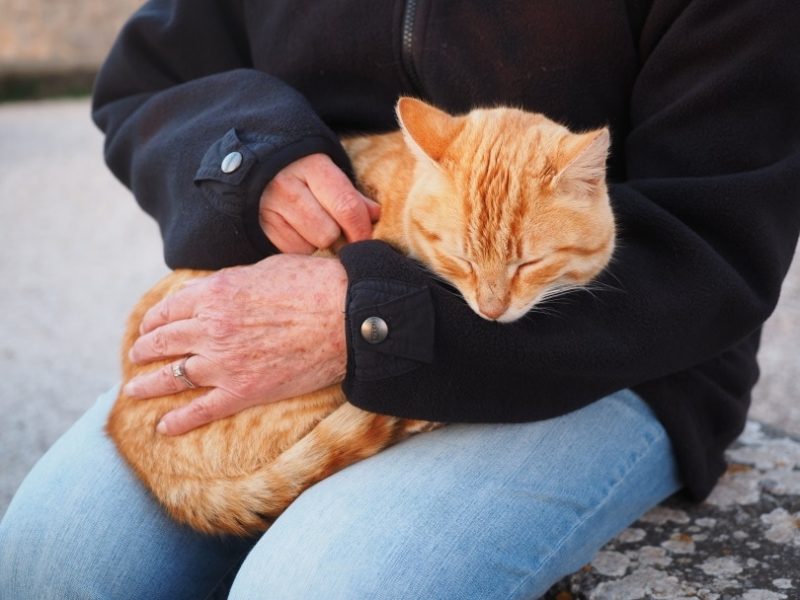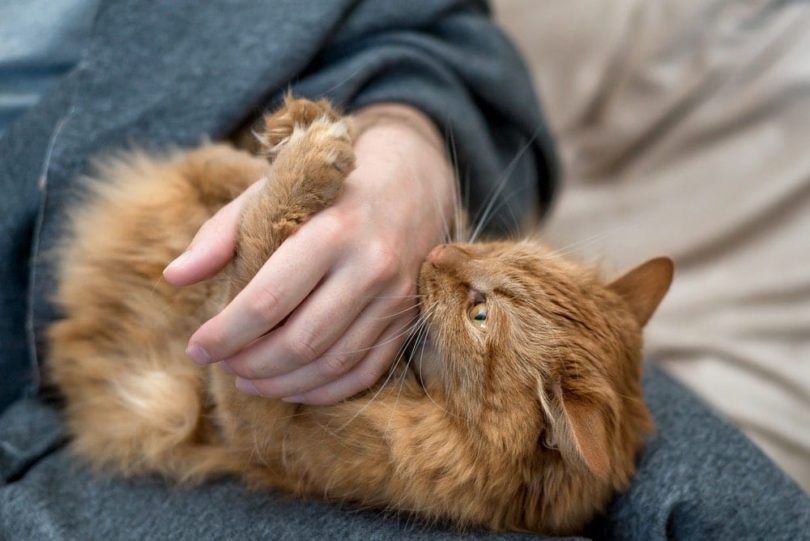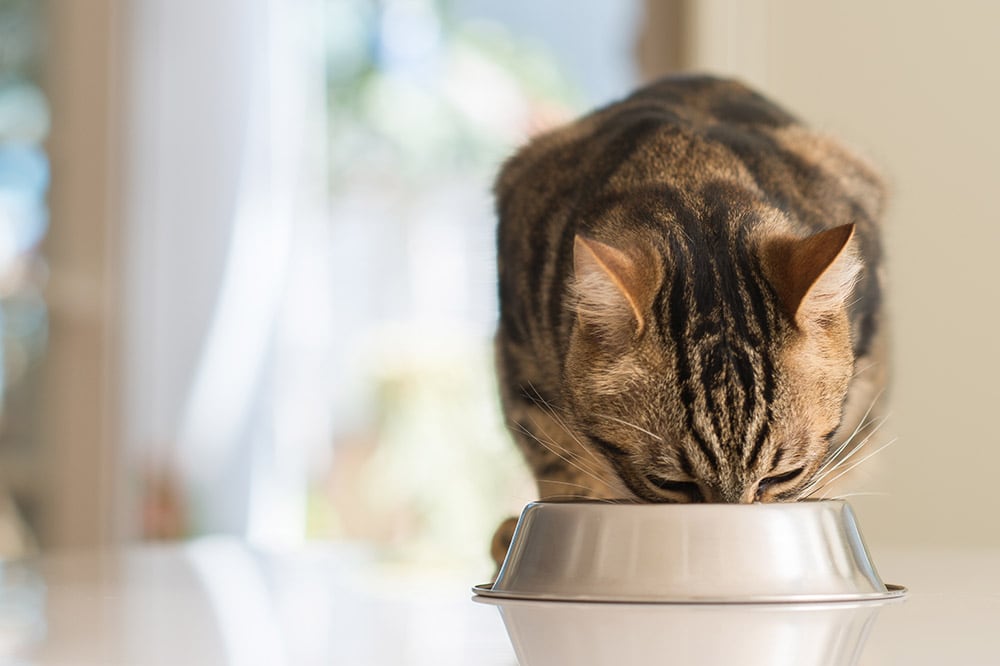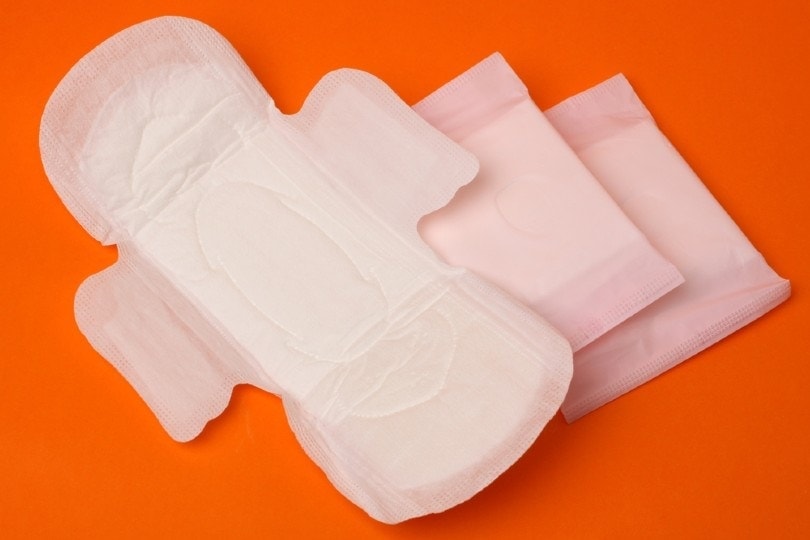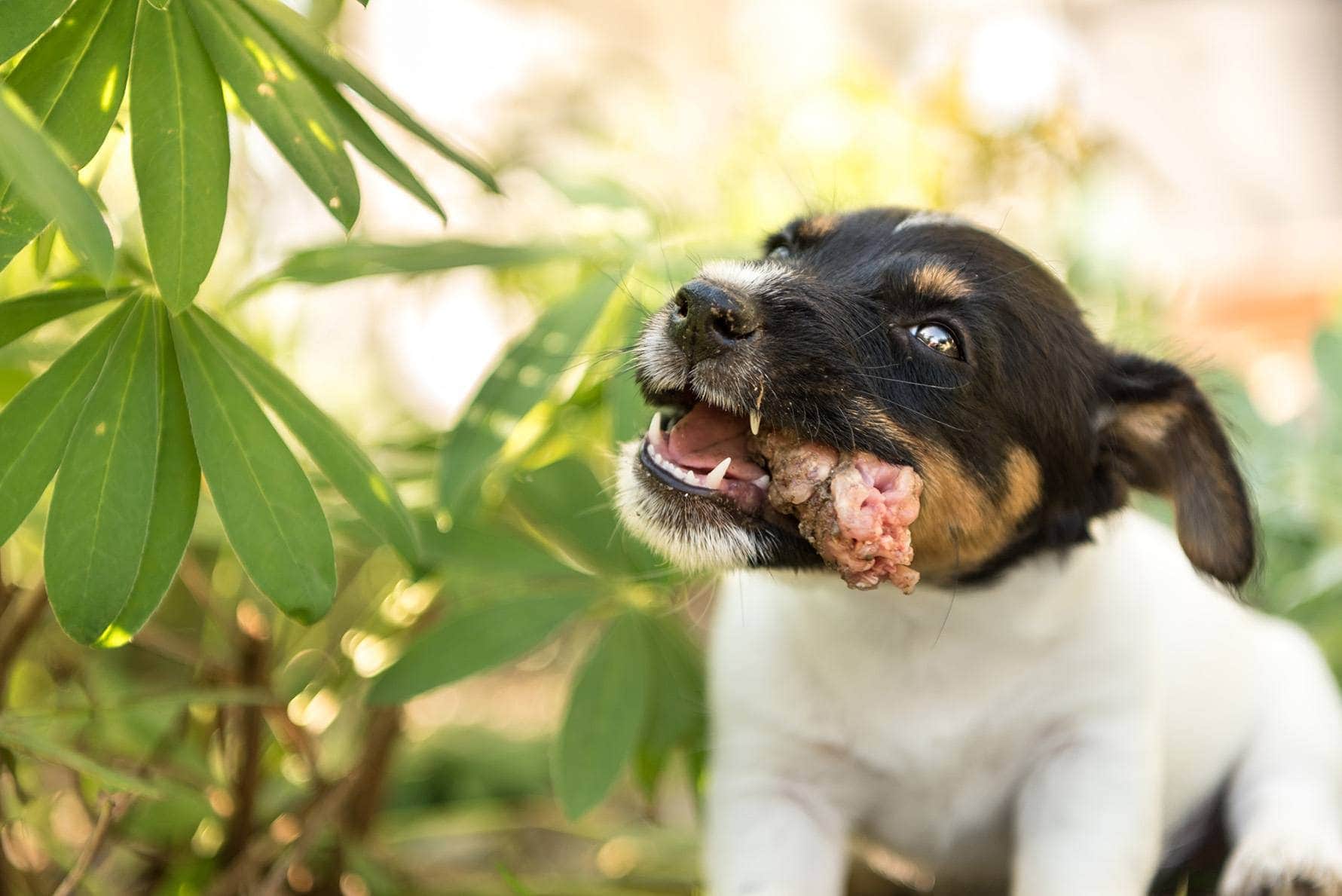10 Vet-Approved Homemade Cat Food Recipes Every Cat Will Love

Updated on
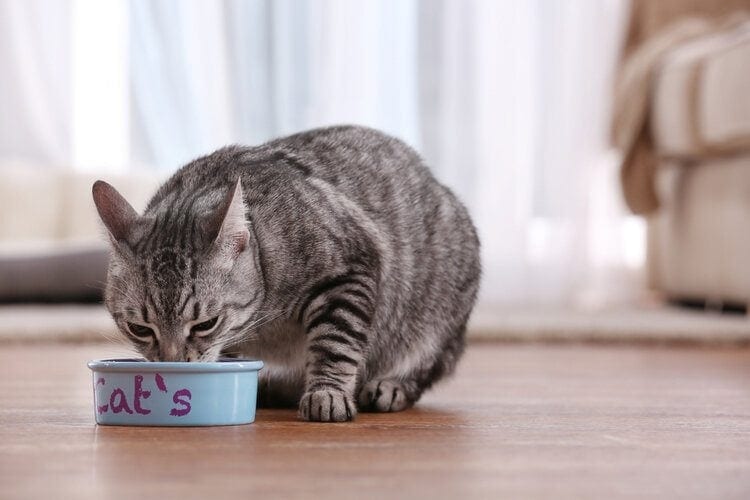
When it comes to a healthy cat diet, it’s almost impossible to make it ideal. Whether you use wet or dry cat food, there are always some drawbacks in formulas – these can be low-quality ingredients, chemicals, preservatives, or artificial components that enhance the flavors, or adjust the texture of the foods. Besides, new research links highly processed pet food to disease due to its content of large amounts of advanced glycation end products.1
One of the biggest challenges of feeding your cat a delicious homemade diet is making sure that it is complete, balanced, and species-appropriate, which will definitely require some supplementation. Keep reading to find our four favorite vet-approved homemade cat food recipes, plus six excellent homemade cat food recipes from other veterinarians and vet nutritionists. Please note that getting the measurements right is important, so you may want to invest in a good kitchen scale.
Top 10 Homemade Cat Food Recipes:
These recipes are calculated for a neutered male cat that weighs approximately 8 pounds, so the average caloric content is 220 calories. When preparing homemade food for your cat, you will want to cater specifically to your cat’s needs. Important factors to consider are gender, weight, life stage, and whether they are desexed, pregnant, or lactating, as each cat has different nutritional needs. We also always recommend speaking to your veterinarian about your cat’s dietary needs before making any changes.
1. Our Favorite Homemade Cat Food Recipe
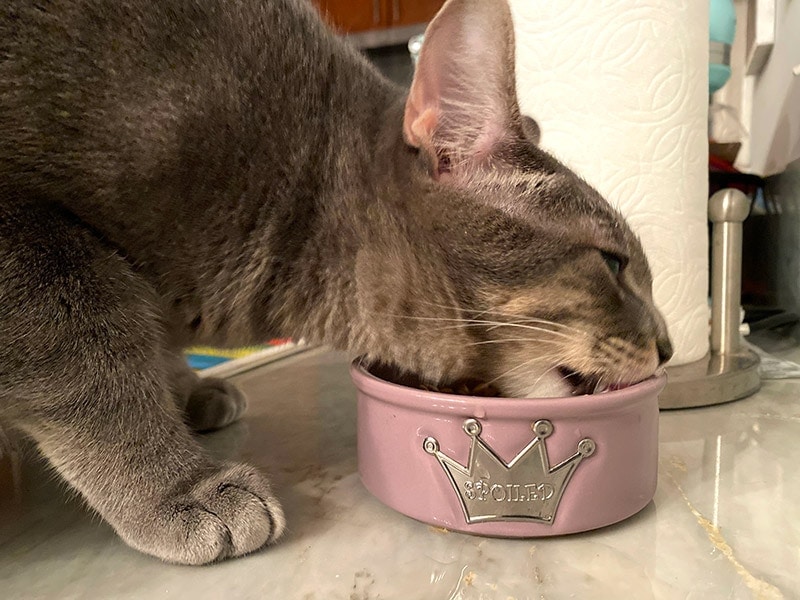
Easy Homemade Cat Food with Chicken, Spinach & Quinoa
Equipment
- Large bowl
- Spoon
- Airtight container (for storage)
- Kitchen Scale
Ingredients
- 74 gr baked chicken breast, skinless, boneless
- 46 gr quinoa cooked
- 23 gr spinach, boiled, unsalted
- 1 teaspoon canola oil
- 0.3 gr Nordic Naturals Omega-3 Pet Liquid
- 0.38 gr Morton Ionized Salt
- 3.62 gr Balance IT® supplement®
Instructions
- Thoroughly shred the baked chicken breast and add to the bowl.
- Chop the spinach into small pieces.
- Mix all these ingredients together in a bowl and the meal is ready. If your cat prefers a more pate-like consistency you can blend it with a little bit of clean drinking water.
- Dive into the number of meals your cat receives in a day.
- Store the leftovers in your airtight container in the refrigerator.
Notes
Nutrition
2. Homemade Cat Food Recipe With Beef and Carrots
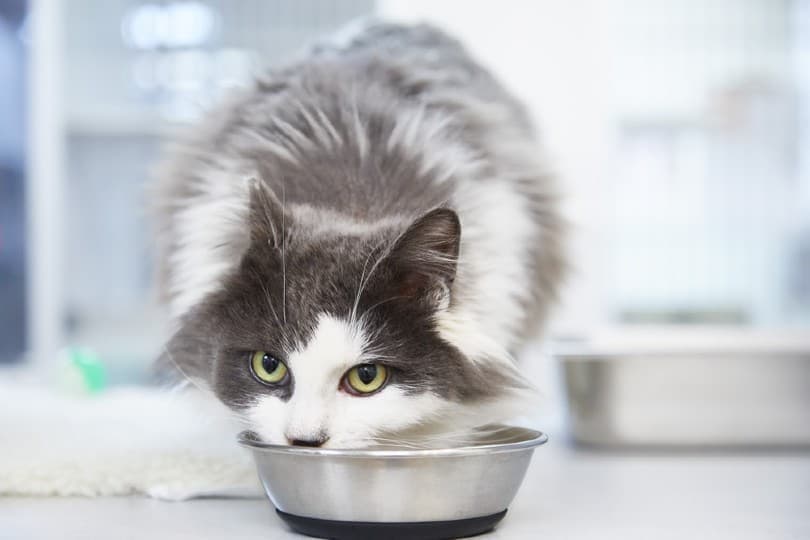
| Servings: | 2-3 meals (one day’s food) |
| Total Calories: | 213 |
| Protein: | 45.3% |
| Fat: | 51.5% |
| Carbohydrates: | 19% |
| Formulated For: | 8-pound neutered male cat |
- 85 gr boiled beef, ground, 95% lean meat / 5% fat (avoid seasoning and salt)
- 110 gr grated carrots (raw)
- 3 gr canola oil
- 0.2 gr Nordic Naturals Omega-3 Pet Liquid
- 0.38 gr Morton Ionized Salt
- 2.56 gr Balance IT ® Feline®
Sauté the beef using little to no fat. Grate the carrots, then mix all of the ingredients (including the canola oil) in a bowl. Divide into two or three servings depending on the number of meals your cat gets in a day. Serve one and refrigerate the rest in a sealed container to feed on the next meal.
3. Homemade Cat Food Recipe With Turkey and Squash
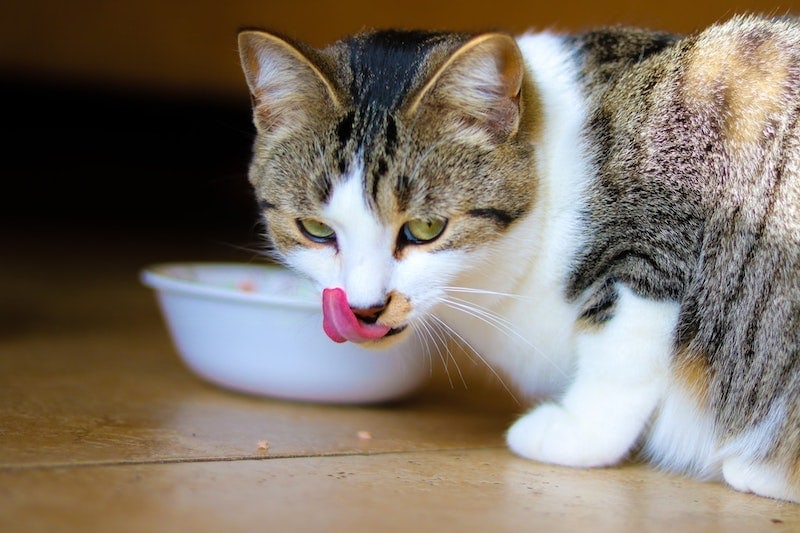
| Servings: | 2-3 meals (one day’s food) |
| Total Calories: | 263 |
| Protein: | 48.5% |
| Fat: | 34.3% |
| Carbohydrates: | 17.2% |
| Formulated For: | 8-pound neutered male cat |
- 85 gr of turkey breast, roasted, shredded
- 158 gr boiled, drained spinach
- 158 gr squash or summer zucchini, boiled with skin and chopped
- 7 gr canola oil
- 0.75 gr Morton Ionized Salt
- 3.26 gr Balance IT ® Feline®
After you have roasted the turkey breast and boiled the vegetables, all you have to do is blend these ingredients. Divide into the number of servings your cat gets in a day. Serve one, and refrigerate the rest in a sealed container to feed on the next meal.
4. Lamb and Asparagus Homemade Cat Food
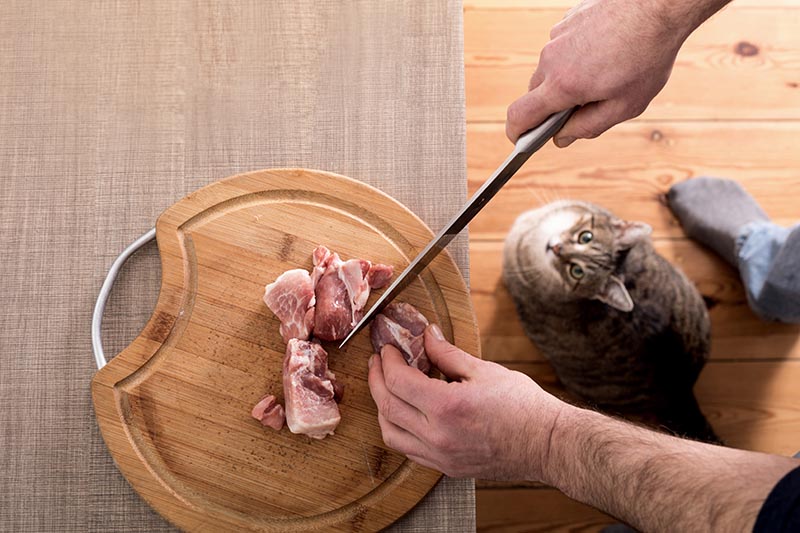
| Servings: | 2-3 meals (one day’s food) |
| Total Calories: | 225 |
| Protein: | 48.7% |
| Fat: | 33.7% |
| Carbohydrates: | 17.6% |
| Formulated For: | 8-pound neutered male cat |
- 38 gr Lamb, sirloin chops, boneless, lean only 1/8″ fat, cooked, broiled
- 120 gr Egg white, weigh before cooking
- 248 gr asparagus boiled and drained
- 5 gr canola oil
- 0.3 gr Nordic Naturals Omega-3 Pet Liquid
- 0.38 gr Morton Ionized Salt
- 2.54 gr Balance IT® Carnivore Blend®
Broil the lamb chops and cut them into tiny bite-size pieces. Weight and cook the egg white. Boil, drain, and finely chop the asparagus. Mix all of the ingredients in a bowl. Divide in two or three servings depending on the number of meals your cat gets in a day. Serve one and refrigerate the rest in a sealed container to feed on the next meal.
5. Dr. Judy Morgans’s Complete Chicken Recipe for Cats
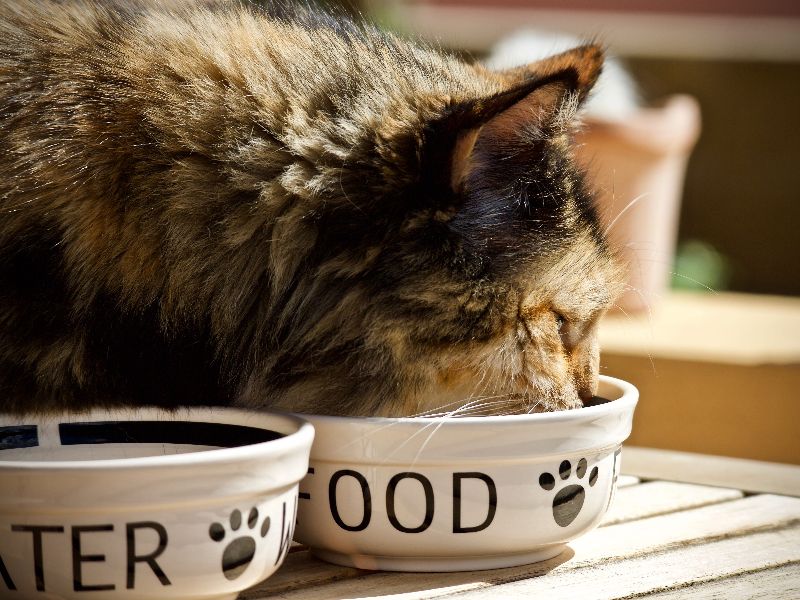
We love Dr. Judy’s chicken-based cat food recipe because it includes superfoods such as kale, cranberries, and turmeric. It also excludes grains and excessive carbohydrates. This is a raw meat-based recipe that your cat will certainly love, so you will need a grinder to prepare this recipe.
6. Dr. Karen Beker’s Adult Feline Cooked Chicken Meal
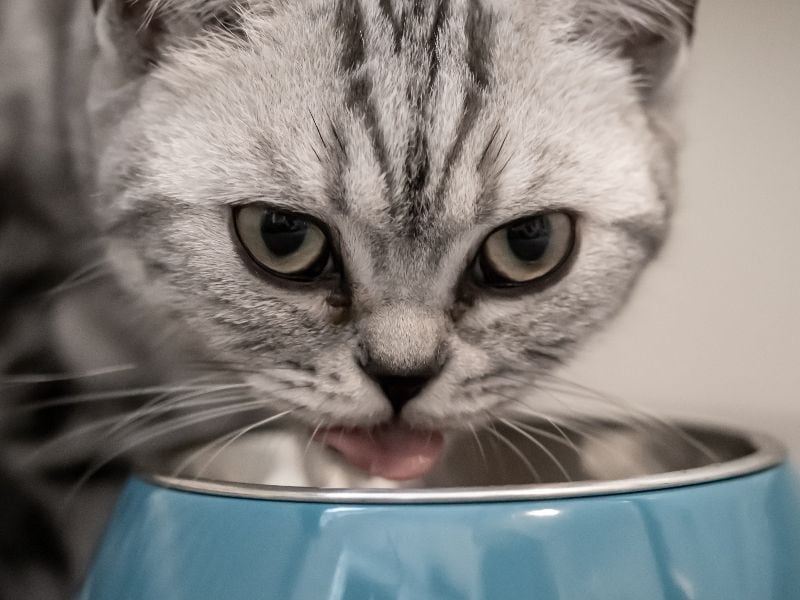
Dr. Beker’s chicken-based homemade cooked cat food recipe is one of our favorites. We love that this recipe includes a complete nutrient profile and kilocalorie content as well as feeding instructions! It is important to note that this recipe is formulated for maintenance, which means this recipe is for adult cats only.
7. Holistic Vet’s Homemade Cat Food Recipes Vet Approved | Basic Blueprint
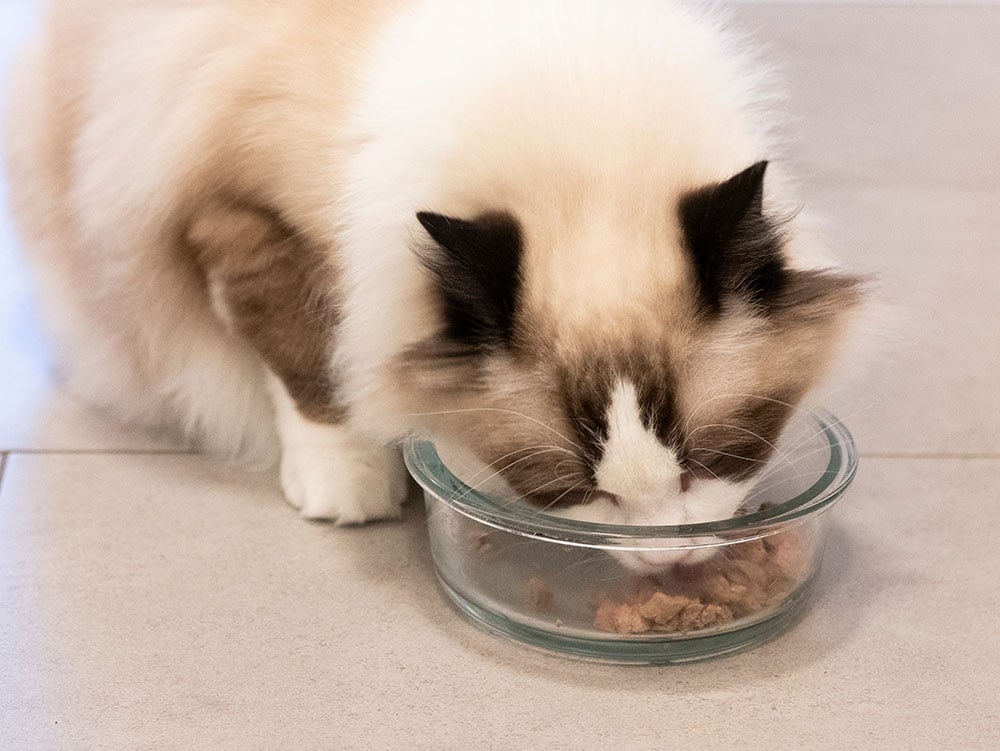
This is a basic homemade cat food recipe blueprint. We love the Holistic Vet recipes because they are based on your choice of protein and healthy add-ons. The holistic vet has her own line of supplements allowing kittie parents to prepare a variety of complete and balanced meals. This premix is especially helpful for those who struggle to manage and cook organ meats since the important nutrients they provide have been already included in the premix. This particular recipe is enough to feed your cat for five to six days.
8. Dr. Jones’ Tasty Homemade Cat Food Recipe (Turkey)
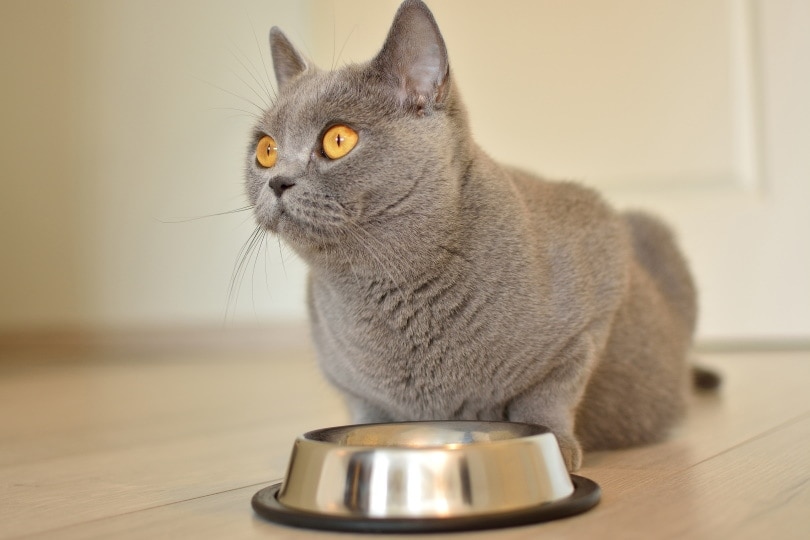
Dr. Jones’s tasty turkey cat food recipe is easy to prepare. Using eggshell as a calcium supplement and ground flax seed for fiber. Dr. Jone explains step by step how to prepare, supplement and serve this delicious cat food.
9. Dr. Michael Fox’s Homemade ‘Natural’ Diet for Cats

This recipe from the author of “Cat Body, Cat Mind” can be prepared using either chicken, beef, lamb, or turkey. Dr. Fox uses natural ingredients including clams, eggs, cottage cheese, gelatin, and supplements such as kelp, calcium, and nutritional yeast to build delicious recipes for your beloved cat.
10. Lucky Feral’s Homecooked Cat Food Recipe
This homemade cooked cat food recipe from Lucky Feral’s is so well prepared that it made it to our list. We love how easy this recipe is to put together, is based on purely natural ingredients starting with chicken legs, hearts, and livers as a source of healthy animal proteins and including a low amount, less than 10% of steamed vegetables as a source of fiber. Using powdered eggshells as a source of calcium and taurine, B complex, vitamin E, and kelp powder as a supplement. This recipe also includes sardines as a source of omega-3 fatty acids. This species-appropriate diet is a great option to feed your cats.
Why Make Homemade Cat Food?
Each cat has individual needs, and covering them all with mass-market industrial products isn’t always the right decision.
Besides, cats are carnivores – they eat raw meat and don’t really need grains. This is what many owners forget about when buying kibbles with wheat and corn. As a result, their beloved pets suffer from stomach upset, sensitivities, poor digestion, being overweight, metabolic problems, and so on.
Ideally, a feline diet should mimic what these hunters ate originally – prey. If you measure a mouse’s nutritional content on a dry matter basis, the nutritional profile would be 55% protein, 45% fat, and only 1-2% carbohydrate. That’s the reasoning behind our vet-approved homemade cat food recipes: they mimic the macronutrient profile of a mouse.
If you’re still wondering why to bother making cat food, take into account the following advantages.
1. It’s All-Natural
Have you ever thought about what makes dry and wet cat food store for so long? Why does it last for a year without changing flavor and properties? Even the best cat foods involve extra processing and adding artificial preservatives. It’s not good for a cat’s health since many pets are allergic to chemical preservatives and flavors, but the signs of allergy might be even unnoticeable. Besides, homemade food for cats has more natural nutrients, vitamins, and minerals. They are preserved in fresh products and digested quickly.
2. It Has Pure Protein
Commercial cat food has 26-35% protein. Not only do meat and eggs serve as the source of this nutrient – but many manufacturers also add soy and bean products. Those components aren’t equally good for all cats. Some pets develop allergic reactions to peas, lentils, and soy.
3. There’s Nothing Extra
What else is included in cat food? Manufacturers add plant-based oils, various grains and seeds, and other questionable products that serve as the source of carbs and fats. They might cause various health problems and are not digested efficiently. There’s a huge list of other ingredients that are not present in natural cat food recipes. The latter allows for avoiding potentially dangerous products.
So, if you’re not afraid that you won’t be able to store the food for a long time or that you will miss a chance to use an automatic feeder – homemade cat food is a great option for you!
The 7 Essential Nutrients in a Cat’s Diet:
What should be included in the cat’s recipes? There are several nutrients that must be in any food you serve to your cat:
1. Protein
Before you start formulating the recipes when cooking for cats, you should find out how much protein your cat needs. It roughly depends on the life stage, but the average norm should be defined individually by a vet. If you serve natural food, include meat (chicken, turkey, beef, or rabbit) and eggs – those are the primary source of protein for cats. This is the basics of cat nutrition: by following them, you ensure the proper growth and development of muscles.
2. Fats
Although excessive fat leads to obesity, it’s essential for absorbing vitamins and minerals. Fat is a very important energy source for cats, second only to proteins. Besides, it’s used to absorb fatty acids, which are important for reproduction, wound healing, and healthy skin and coat. Besides, fat and carbs both serve as a source of energy. If your cat is prone to obesity, choose lean meats like chicken or turkey breast. If your pet is undernourished, it can gravitate towards fatty pieces of meat.
3. Carbohydrates
When it comes to carbohydrates, there are no exact numbers given but ideally, they should not exceed 20% of the food. This is relatively difficult to achieve but not impossible, especially feeding a homemade diet.
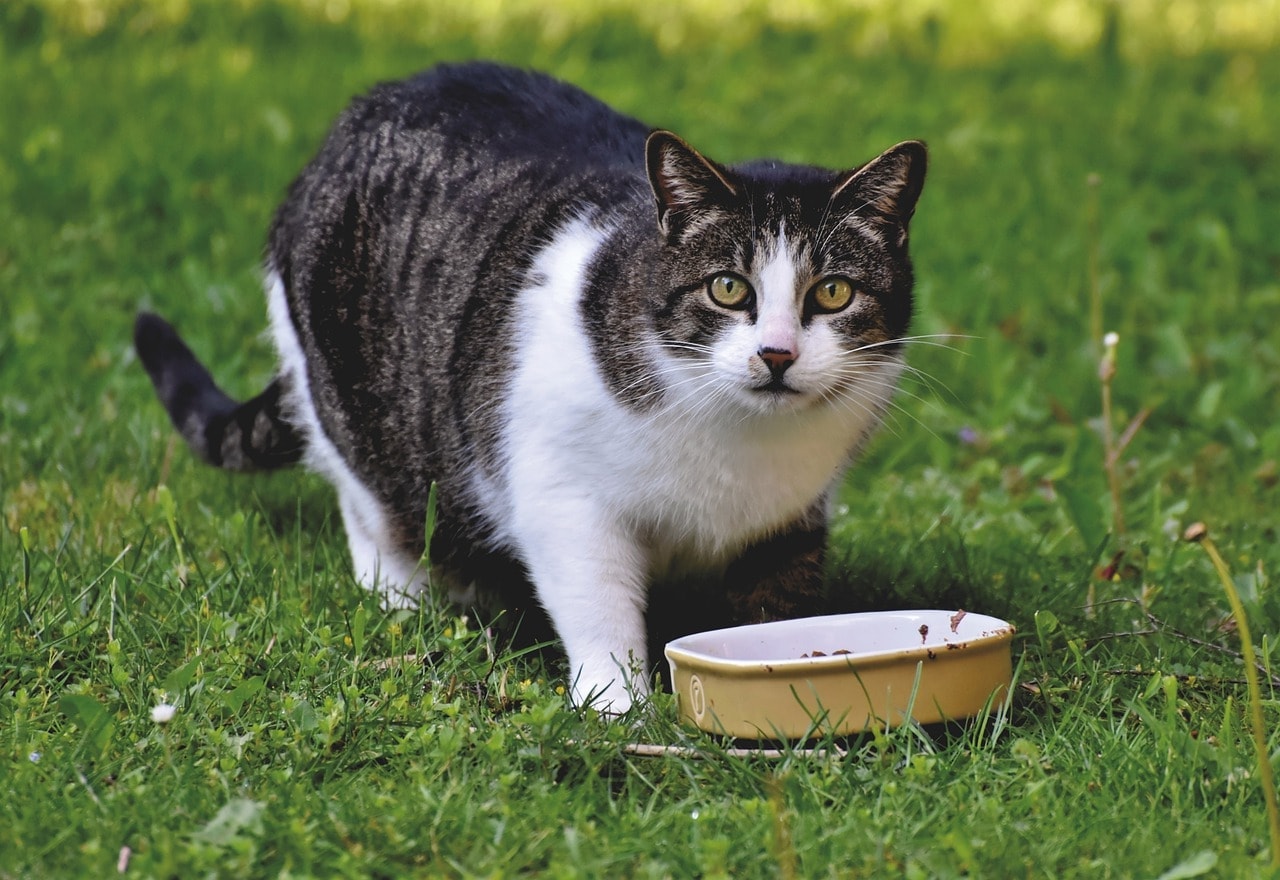
4. Fiber
Fiber is important for ensuring healthy digestion and metabolism. When you define how to make cat food, figure out what will serve as the source of fiber. Some cats love eating vegetables, and others chew berries. While cats can eat berries, like blackberries and strawberries, never let your cat take sips from your smoothie if there are other potentially harmful ingredients included like dairy or grapes. Consult with a vet and find out which sources of fiber will be ideal for your cat. You need to find products that won’t cause gas, diarrhea, constipation, and other adverse effects.
Read more about how fiber affects your cat’s health.
5. Essential Amino Acids
Amino acids are the building blocks of proteins. As obligate carnivores, cats have very specific nutritional requirements. Two amino acids are considered essential for cats since they are unable to synthesize them. These are Taurine and Arginine, both of which are typically supplemented into the cats’ diets. The lack of these nutrients would result in damage to your cat’s organs and health.
Cats lack the enzyme needed to synthesize arginine in their bodies. Arginine is involved in the removal of ammonia, a waste product of protein breakdown from the body. If cats lack supplemental Arginine and they are unable to remove the ammonia from their bodies, they can suffer from vomiting, weight loss, neurological signs, and even death.
Taurine is another essential amino acid that cats, unlike other animals, are unable to synthesize. It plays a very important role in the growth and development of kittens and in the general health of adult cats. If a cat’s diet has inadequate levels of taurine, they will suffer from retinal degeneration, which can lead to blindness, dilated cardiomyopathy, and, in the case of females, also reproductive issues.
6. Vitamins
Here comes the most challenging part, since it’s hard to estimate the number of vitamins in homemade food. Yet, you should be aware of which vitamins are important for felines.
- Vitamin A
- Vitamin D
- Vitamin E
- Vitamin K
- Vitamin B1, B6, B12
- Riboflavin
- Folic acid
- Niacin
- Pantothenic acid
Of special importance are vitamin A and vitamin D since cats are very effective at synthesizing them out of plant precursors. So how can you make sure all of them are present in your cat’s diet? Consult with a veterinarian and make up a plan. If some elements are lacking, you’ll need to give vitamin supplements to your pet.
7. Minerals
Here is the list of minerals that should be present in a cat’s diet:
- Calcium
- Phosphorous
- Magnesium
- Sodium
- Iron
- Manganese
- Selenium
- Iodine
- Chlorine
- Potassium
- Zinc
- Copper
In the same manner, you should discuss the cat’s diet with a veterinarian and find out how to include all of these elements in the food served.
Ingredients to Avoid
Now when you decide how to make your cat food, you should consider one more thing: what should be avoided. We know that some manufacturers add products that are not necessarily ideal for cats.
- Soy: Soy is typically used to increase the protein content in commercial cat food. Soy is not a complete protein source for an obligate carnivore.
- Peas and pea fiber. Although many manufacturers add it as a source of protein, peas have no proven positive effect on the cat’s health since they lack the essential amino acids they obtain from animal proteins, and some might even develop an allergy.
- Corn. Although corn gluten is a source of protein used in commercial pet food, many crops are genetically modified. There has been no study on the long-term effect of GMO products on cats’ bodies, so it’s better to avoid such products.
- Wheat: This is a source of carbohydrates and is not an ideal food for a cat. On extremely rare occasions, cats have developed an allergy to wheat.
- Non-specific meat and meat by-products: If your cat eats non-specific meat by-products in its food and develops an allergy, it will be very difficult for you to find out what is the trigger ingredient. Avoid cat foods with these mystery meats listed as ingredients.
FAQs
How to get my cat to eat homemade cat food?
It will be easier to switch a cat from canned (wet) food to raw or cooked. Typically, the transition takes about a week. You start serving food in a 20/80 ratio, then 40/60, 50/50, and replace the old food gradually. However, the process of transition may take months – don’t give up. Some pet owners suggest starting with raw/cooked food treats, such as chicken wings.
What ingredients are in homemade cat food?
Typically, homemade cat food is made of meat (chicken, turkey, duck, rabbit, fish, pork, lamb), liver, salmon oil, and eggs. Optionally, cat owners can add small portions of grains, vegetables, or fruits. Vitamin supplements are also added to prevent deficiencies.
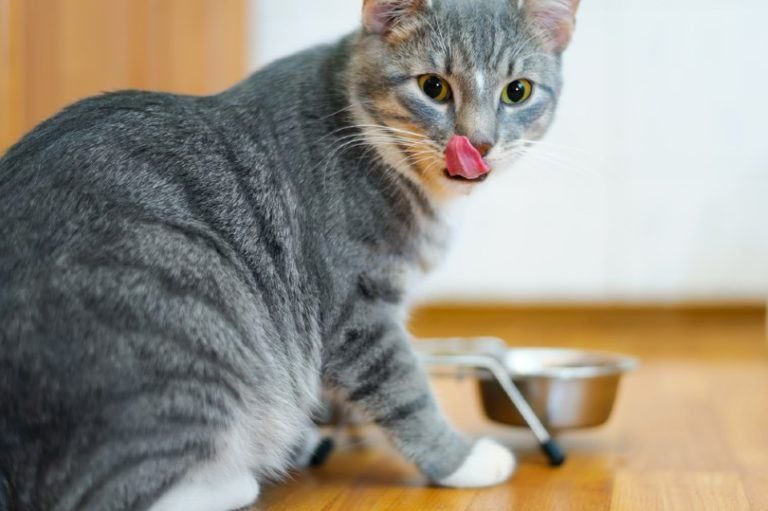
How should I store homemade cat food?
Usually, it’s stored in a refrigerator. Cooked food lasts 24-72 hours from the moment of preparation. If you serve raw meat, you can store meals in the freezer and defrost them before the moment of serving. Frozen food is stored for months without losing its nutrients and properties.
Can I make homemade dry cat food at home?
Yes, it’s possible to cook healthy dry cat food at home. A slow-baking technique is the best for this purpose because it allows for preserving nutrients and maintaining crispy consistency. The recipes and techniques are described in our separate guide.
How can I make healthy homemade cat food?
You should consider all the aspects of healthy feline nutrition to prepare the recipe that would be a healthy option for your feline friend: the amount of protein, fat and carbs should be thoroughly calculated. Also, the food should contain all the required vitamins, micro- and macro-elements. Please, remember that adding the human spices can be harmful, so you should learn about human foods that are toxic for cats.
Final Thoughts
Feline family members have their special nutritional needs – you should consider them when choosing the diet. Cats living on all-natural products are less prone to diseases of the intestinal system and kidneys, not to mention that it allows carnivores to truly enjoy the meals. Now that you know how to make homemade cat food, maintaining the proper balance of nutrients becomes simpler. But before you decide to switch your feline friend to raw or cooked meals, it’s important to consult a veterinarian – a specialist will help you figure out a perfect formula for your pet.
Featured Image Credit: Africa Studio, Shutterstock

